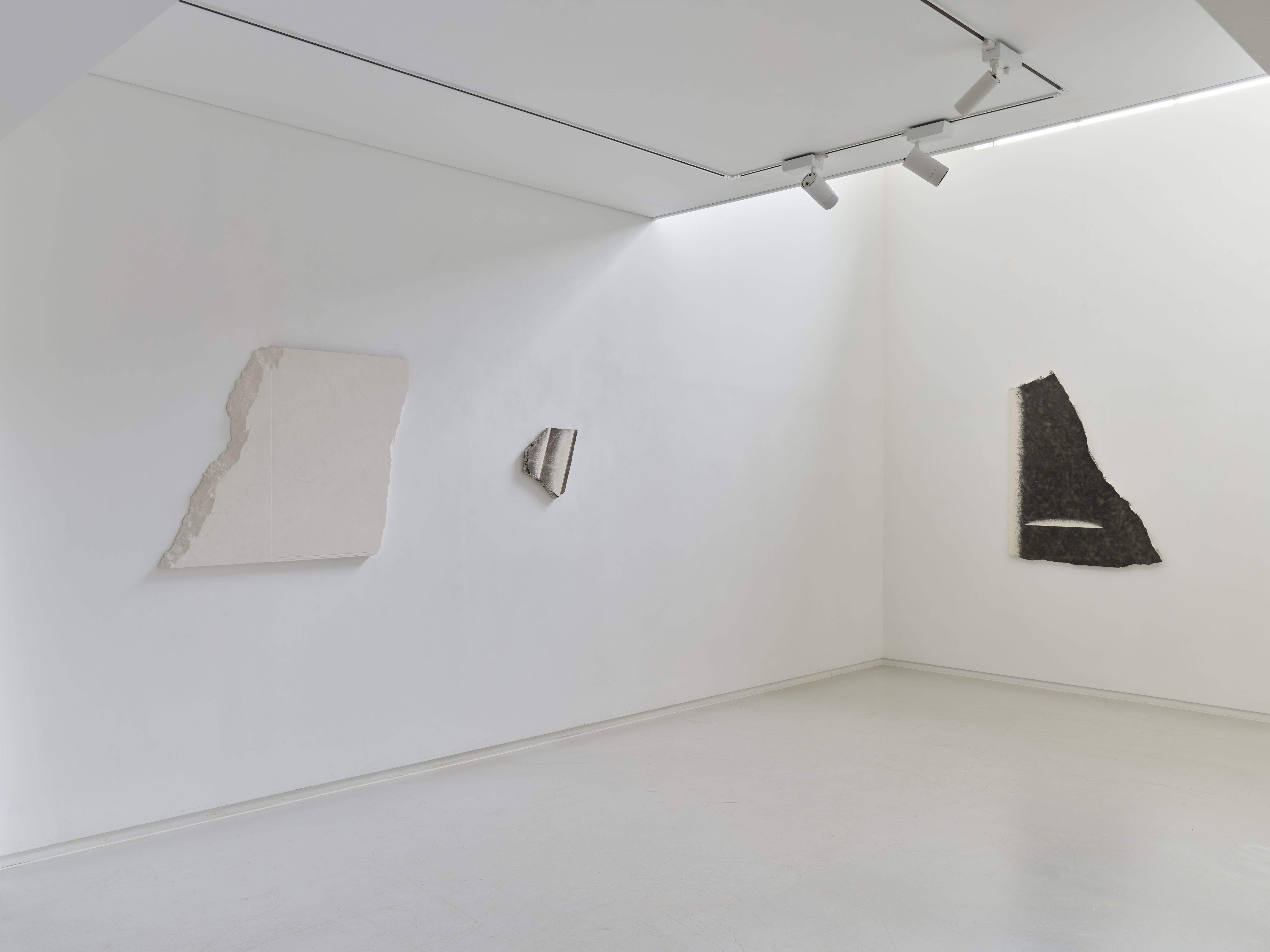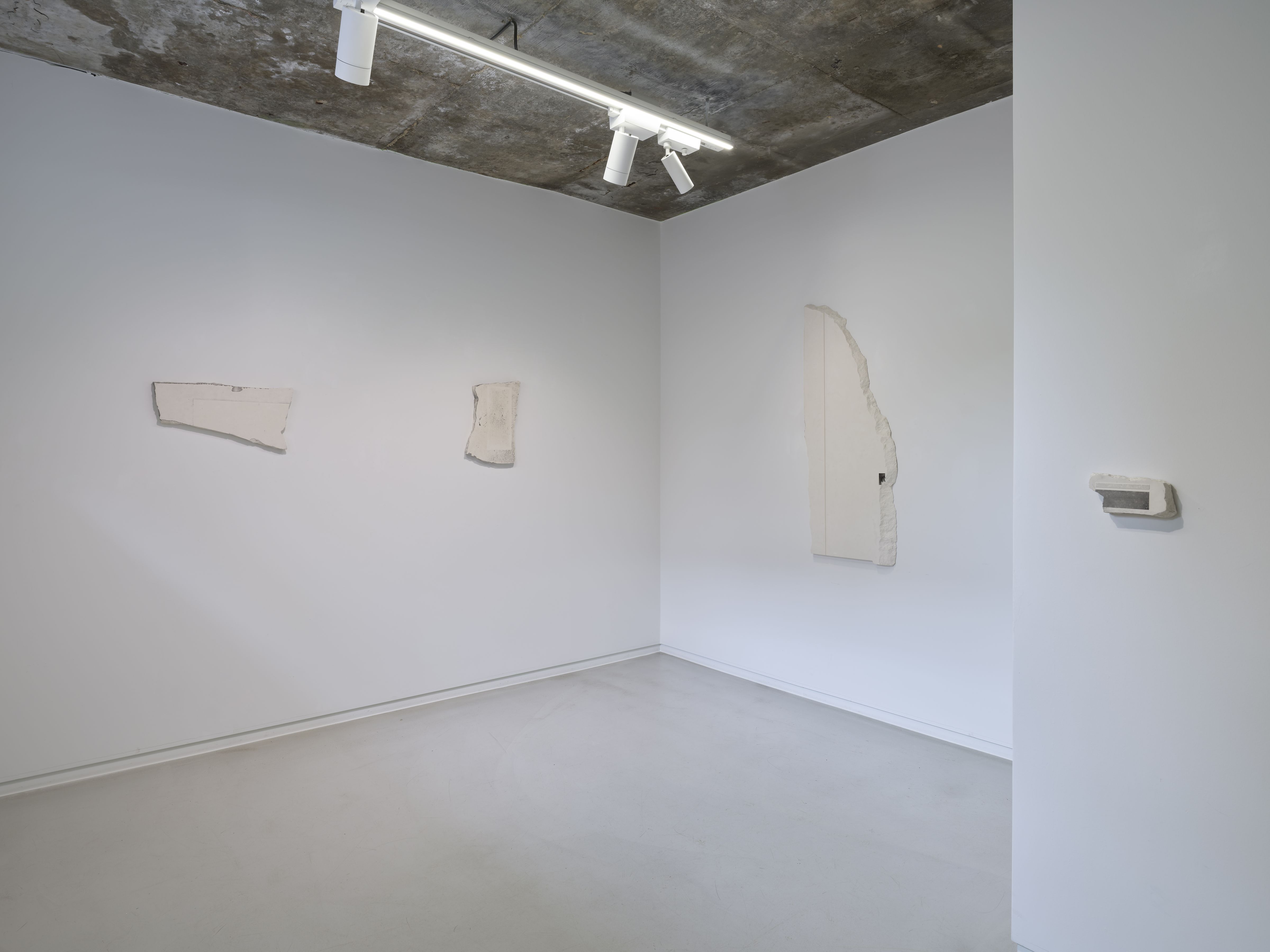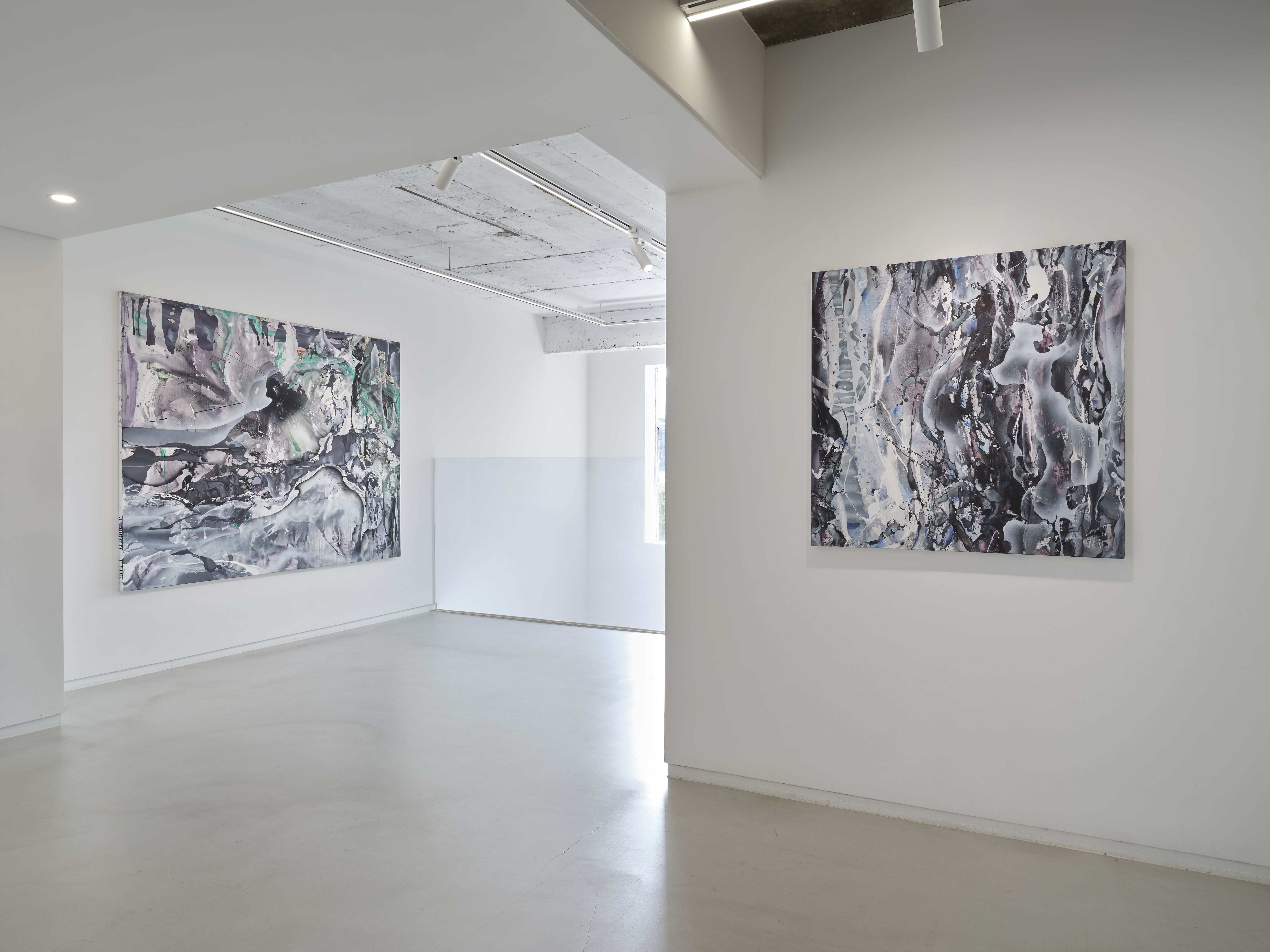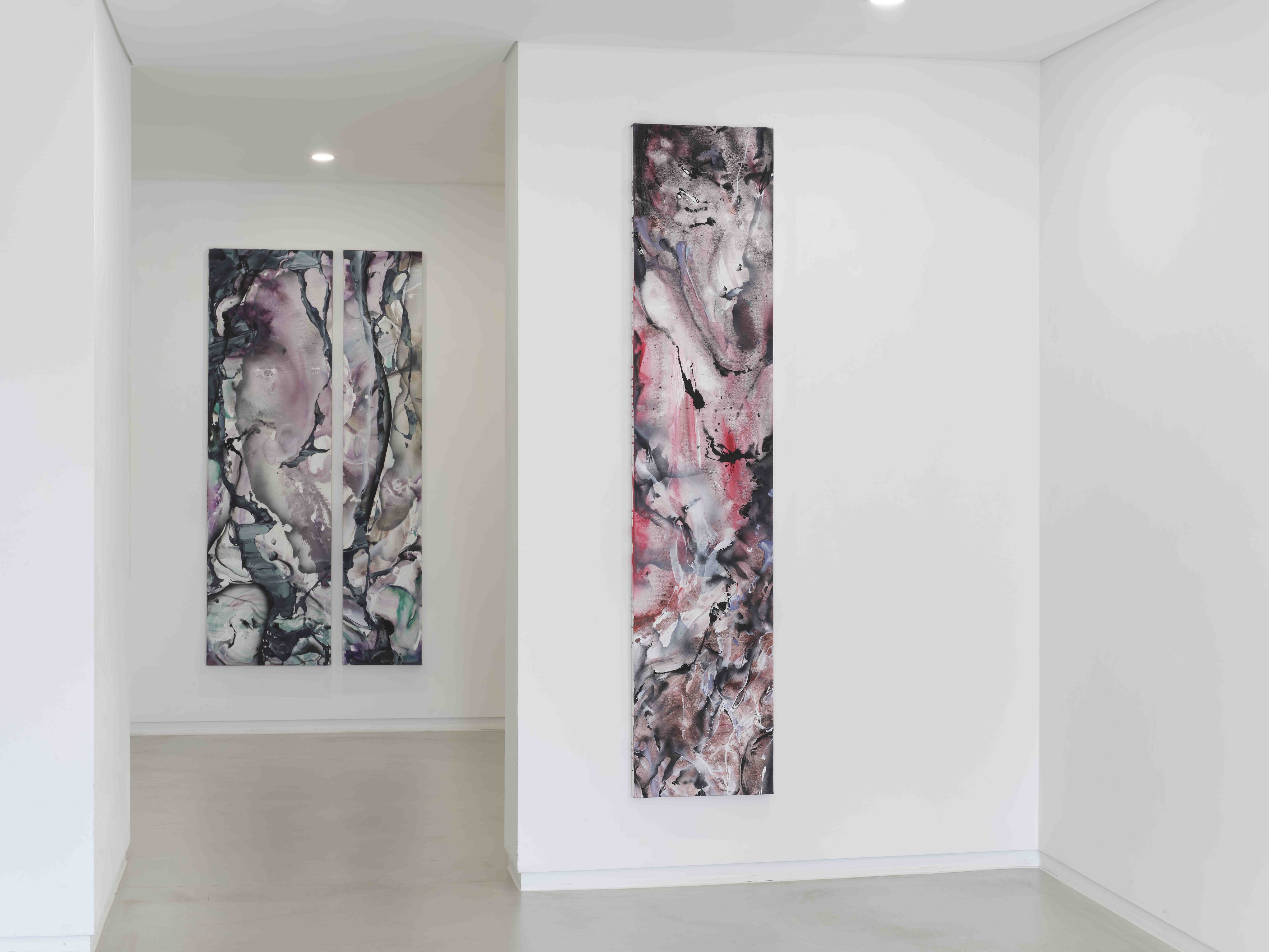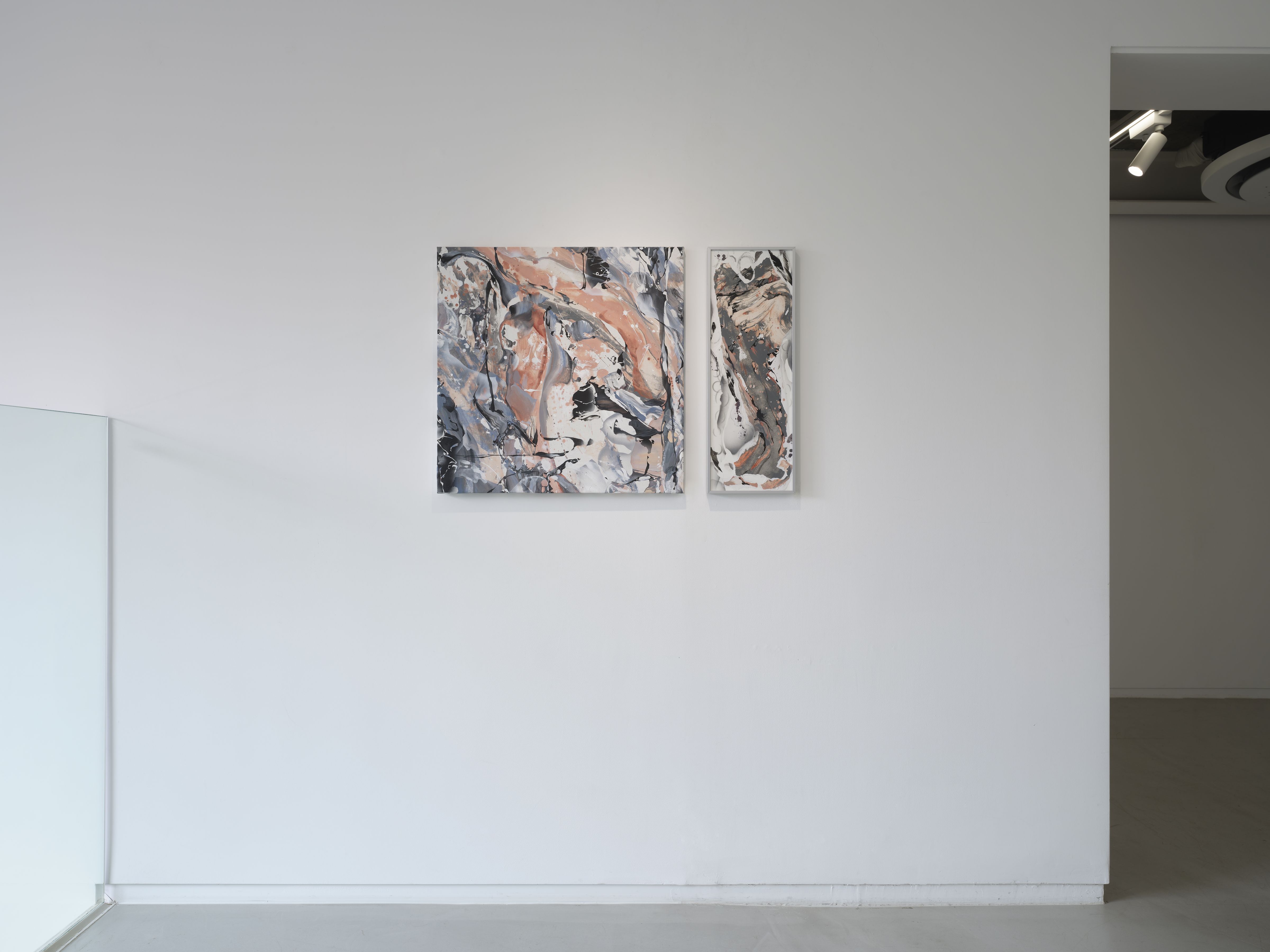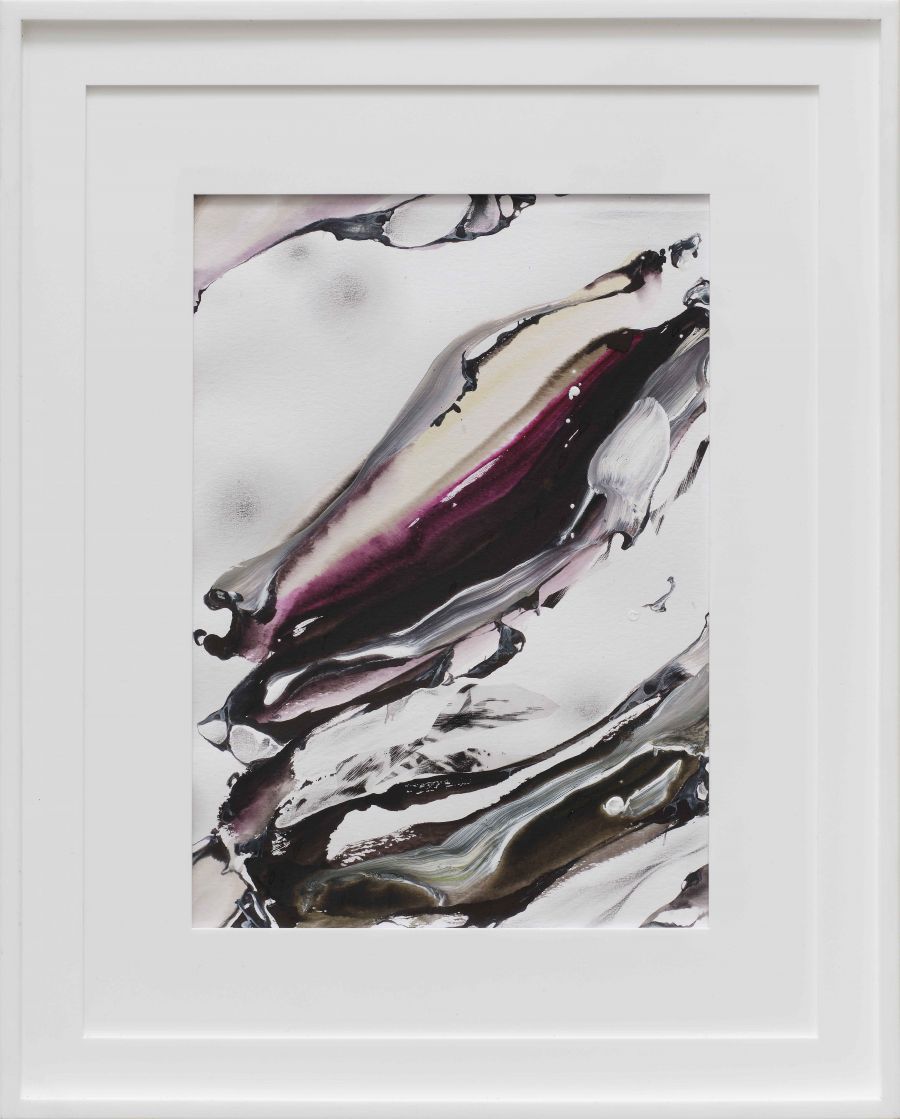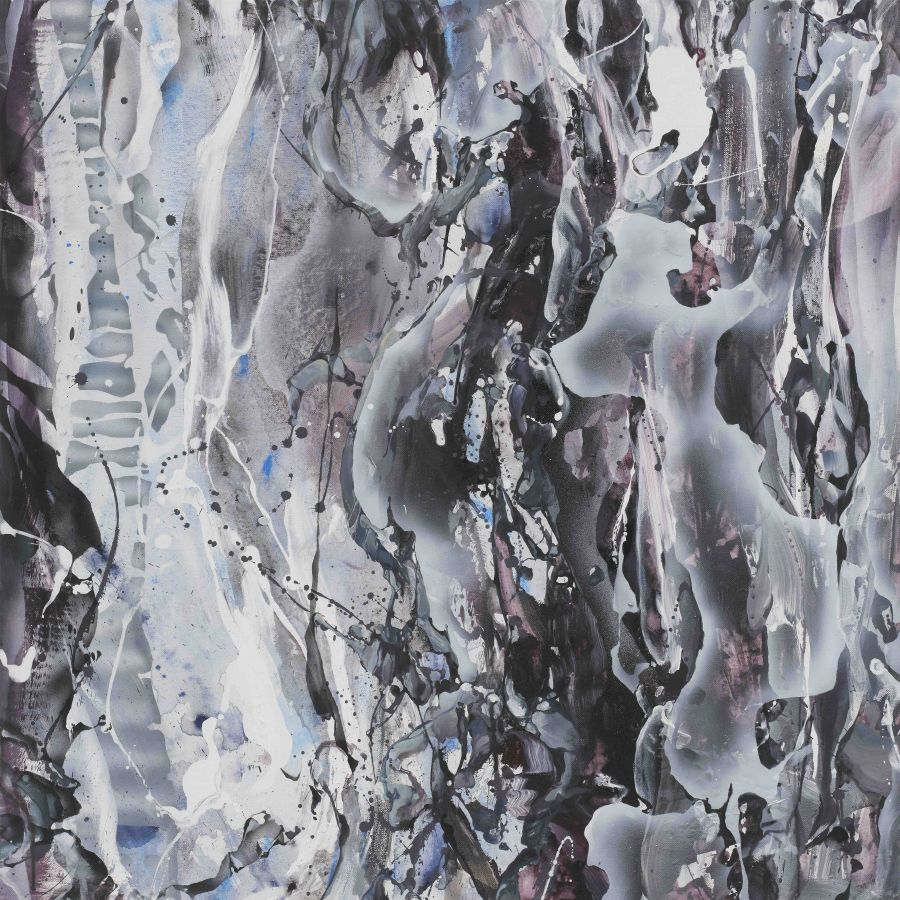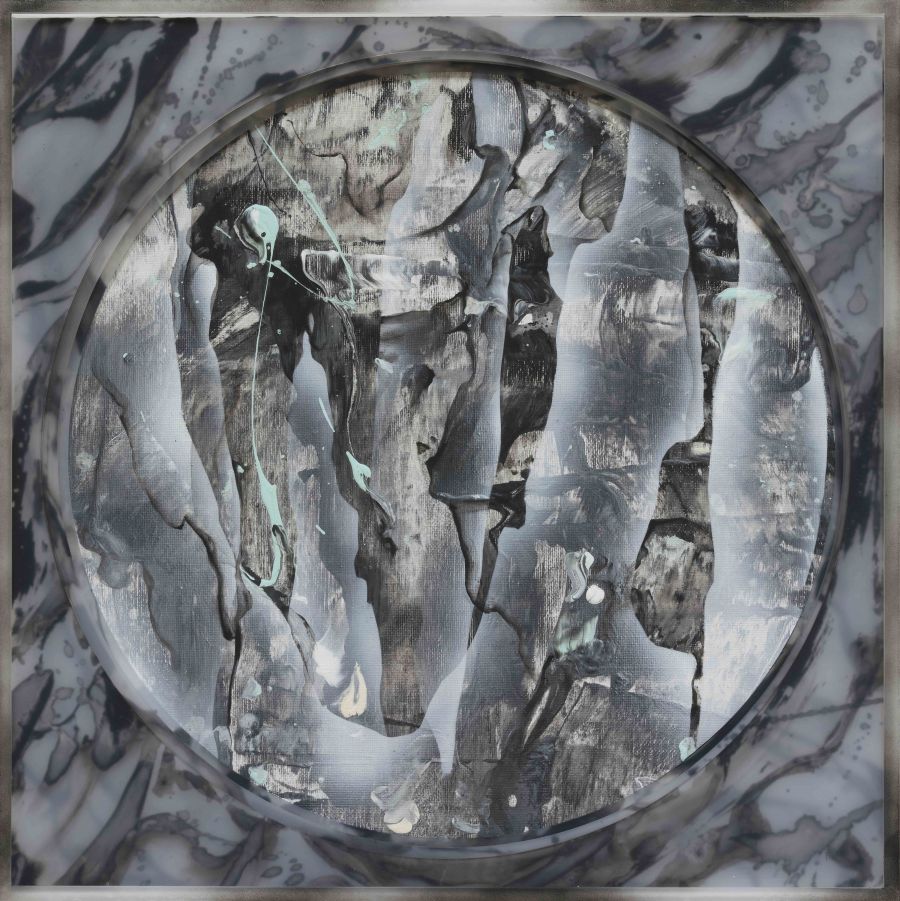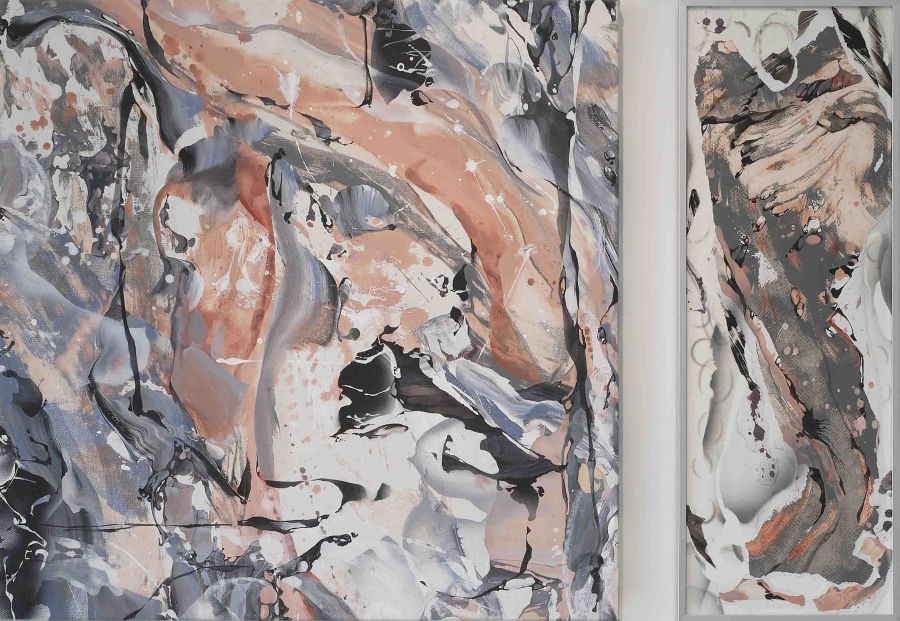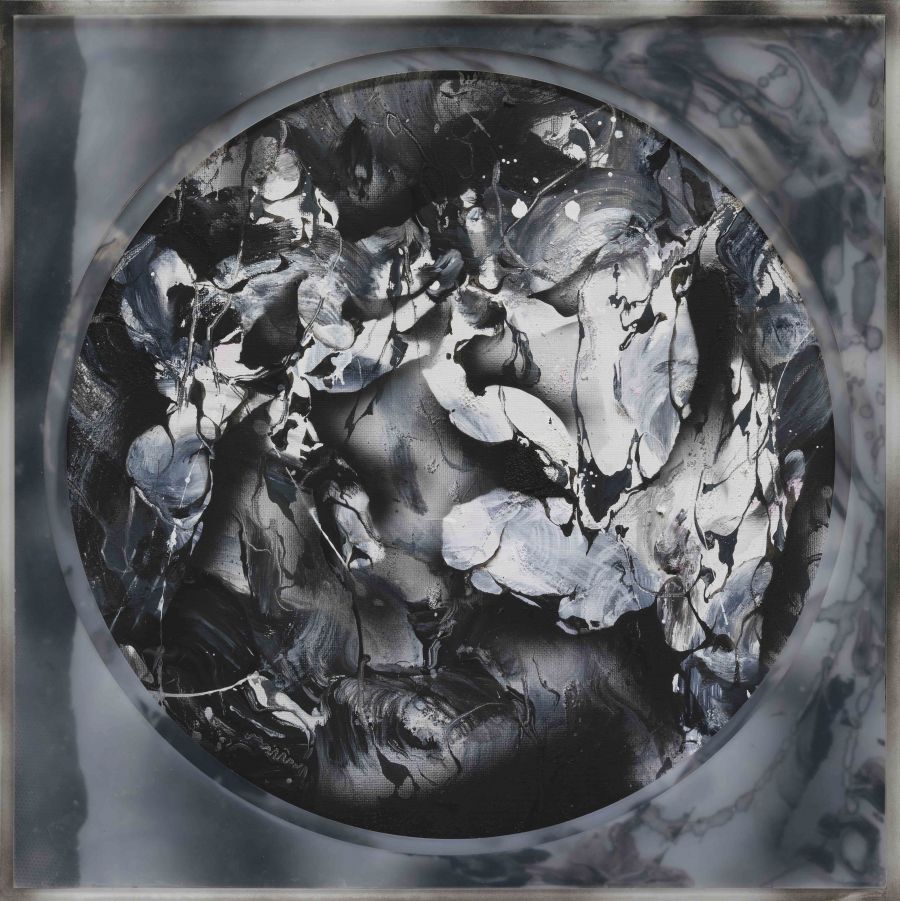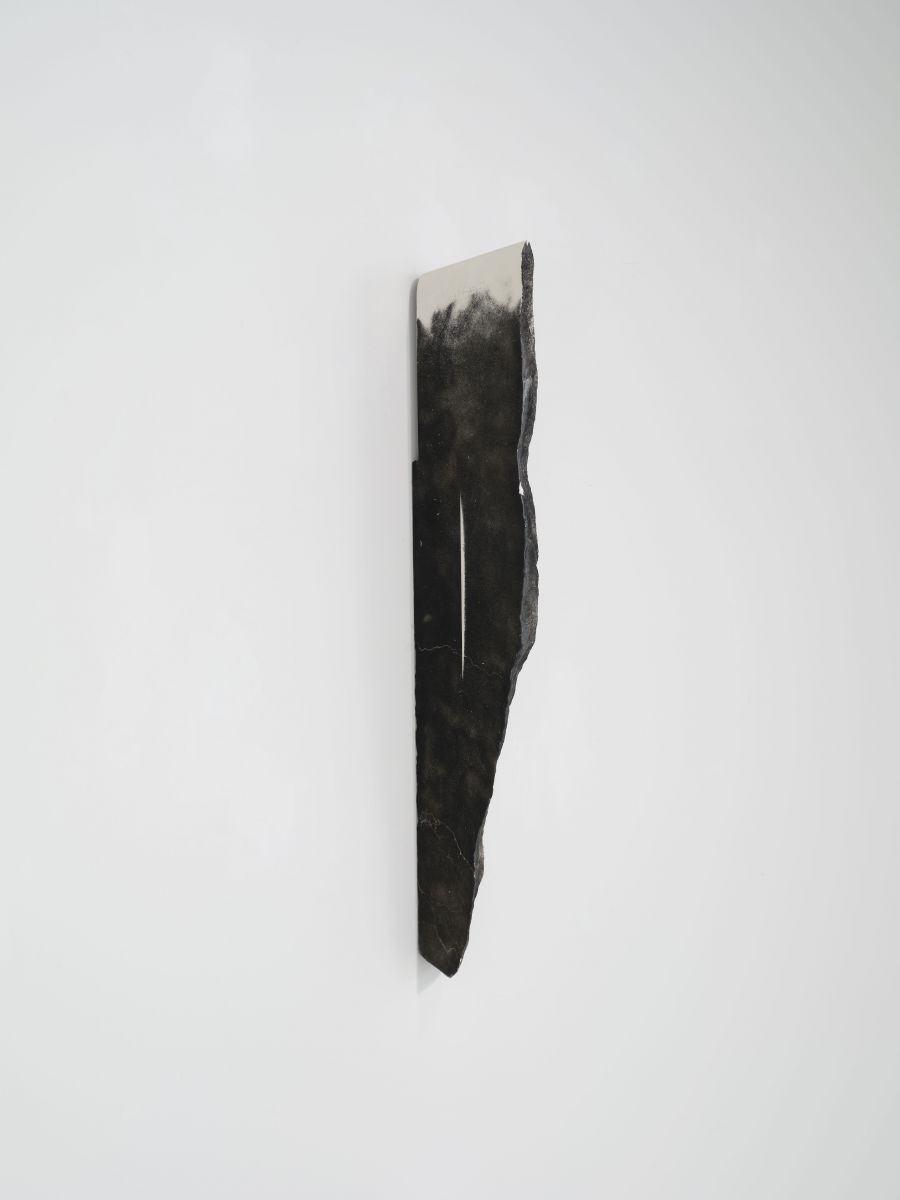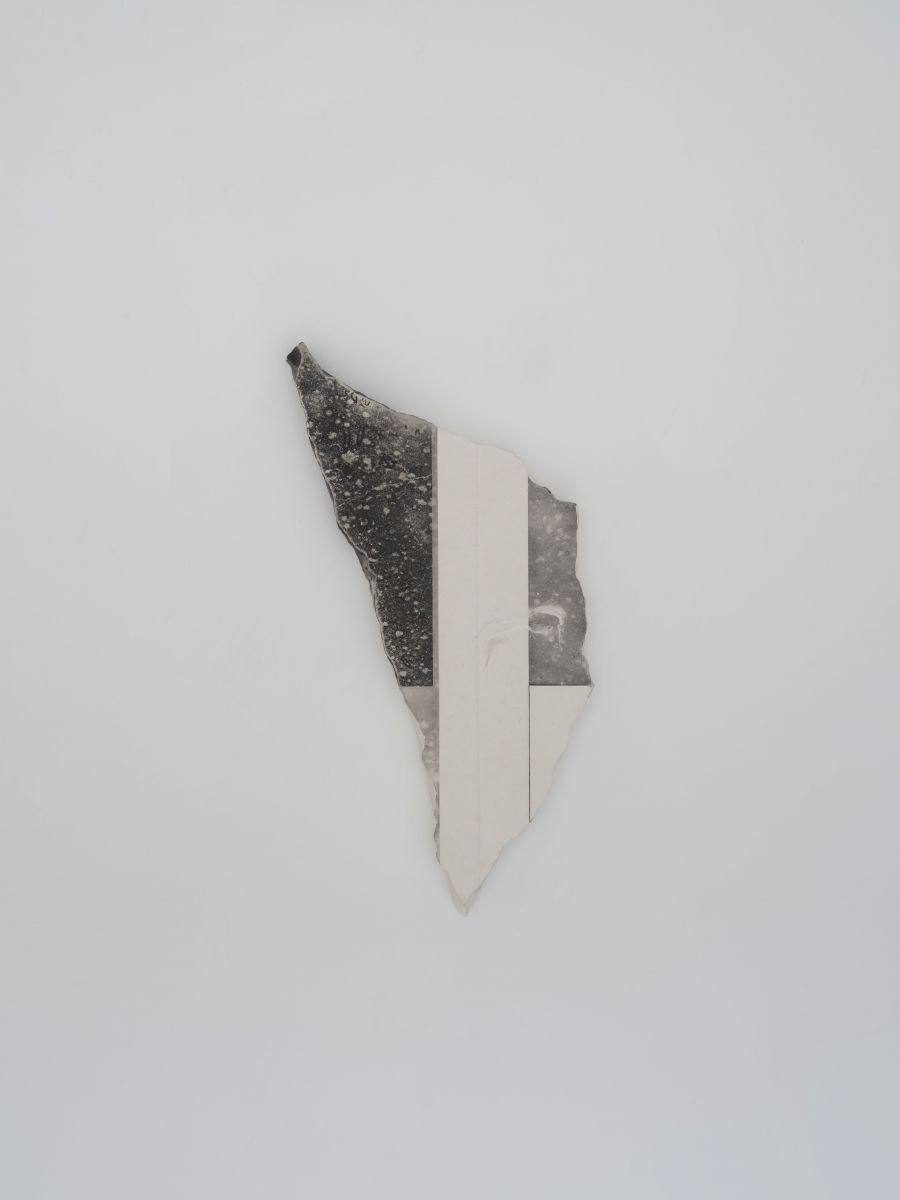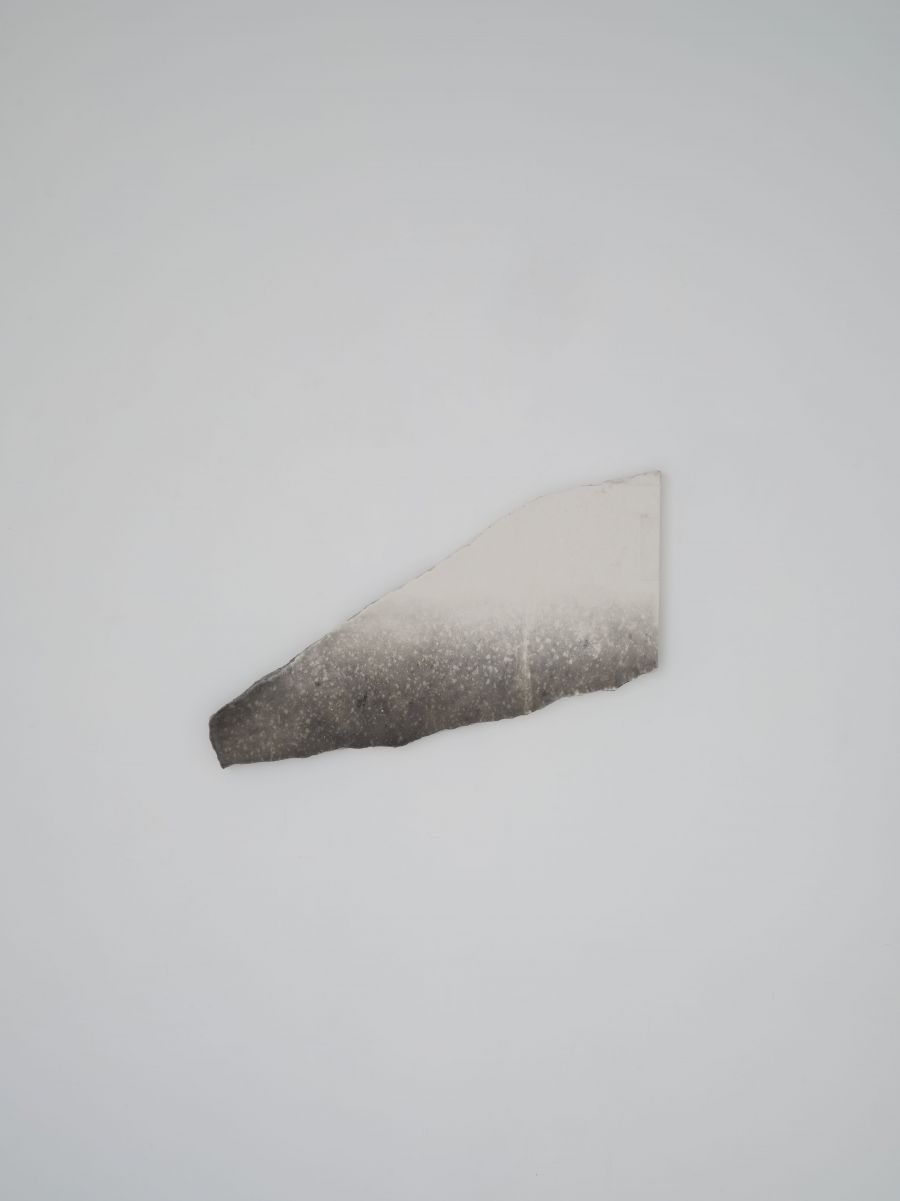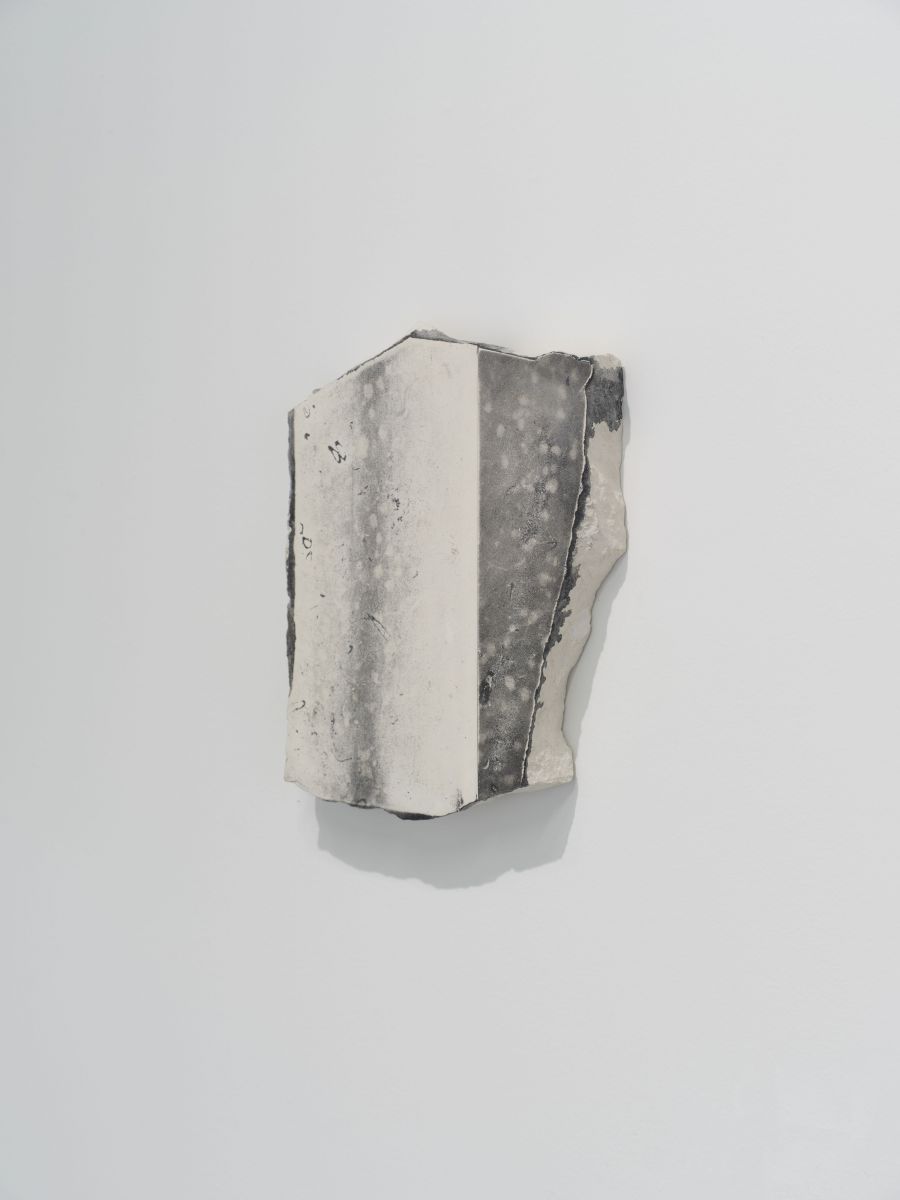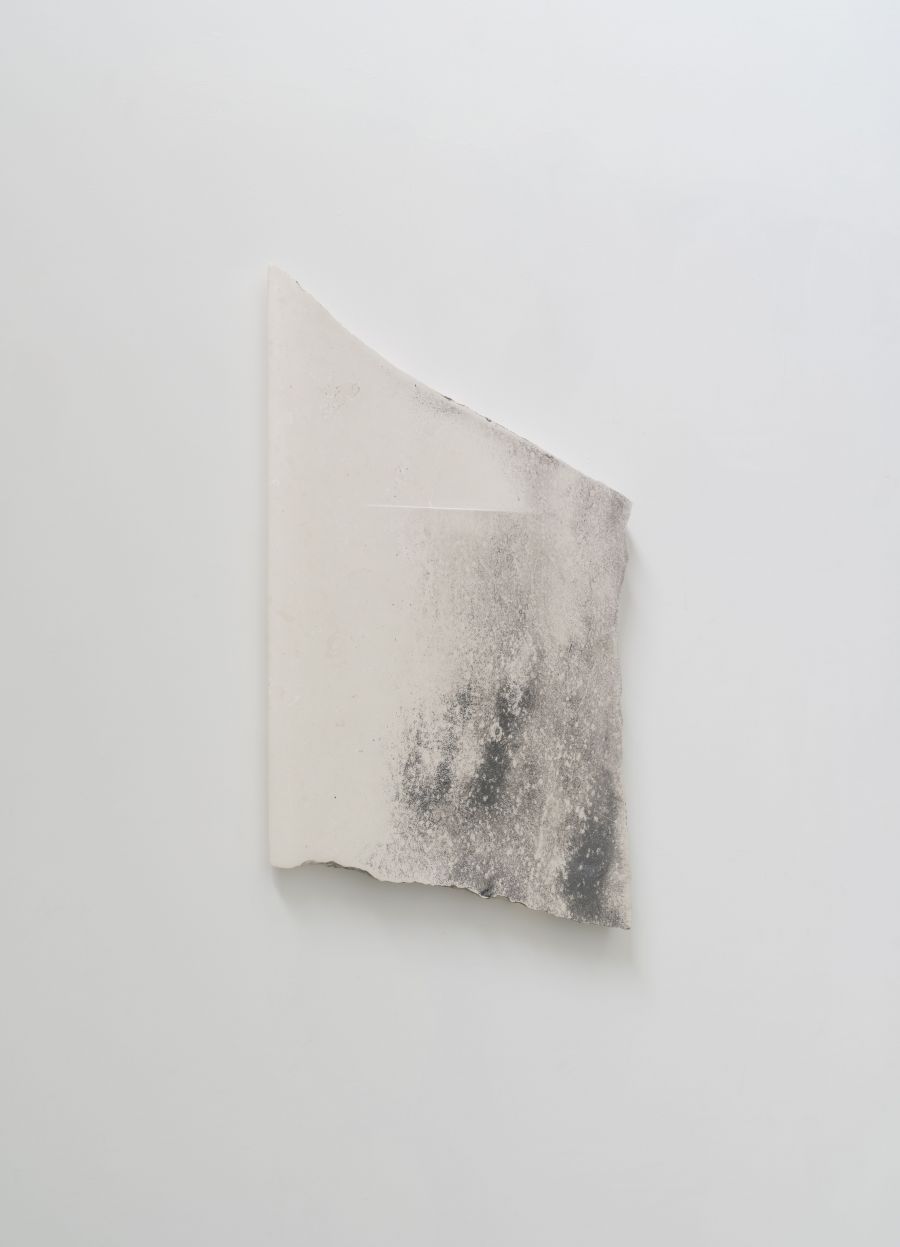“Here” and “Me” are the starting points for perceiving the world. And the time and place where the physical body stands become the coordinates of where the mind is positioned in the world. This exhibition highlights the fact that the material and place dealt with by the two artists, KWON Hyun Bhin and HWANG Wonhae, are not simple objects or spaces, but traces and continuations of events that occur within certain interactions. Moreover, what the artists emphasize in their respective media and working methods is the “distance from the subject.” This aspect shows their approach in using objects or places as the basis for their work while maintaining an appropriate distance to avoid repeating a representational form. In essence, their working method is also a process of finding the balance where they can create some meaning within the subject through the medium of the artists’ “bodies.”
KWON Hyun Bhin’s limestone work reveals the process and traces of events occurring in relation to “here” and “me.” She breaks away from sculpting stones according to a set pattern. Cutting stones to a certain thickness, grinding them flat, and carving lines or shapes on them is a delicate art. On the other hand, breaking a stone, spilling ink, and leaving it to the stone itself invites contingency. It is the artist who adjusts the distance by going back and forth between precision and contingency as if walking a tightrope. For KWON, sculpture is a physical intervention that creates an intended event (the relationship), while at the same time as the title of the work, Mulu implies, it creates a gap so that the object can become itself in the process.
“Stone” is not a simple object to the artist. “Stone” itself is an object and a trace of many events that are deeply related to the artist’s daily life, not only in her childhood, but also in the present. Similarly, the stone sculptures placed flat or upright on the wall are not complete objects, but are open landscapes where countless trajectories of actions and events quietly yet dynamically intertwine.
HWANG Wonhae’s paintings can be understood as “extended bodies” that sense and unfold the relationships and events that occur in multi-layered “places” ranging from urban architecture, airports, and virtual spaces. In that context, the places the artist chooses are symbols that indicate fragments of urban life encountered within its temporality. Using these places as a stepping stone, she imagines the entangled movement of energy and trajectories of events that occur in relation to it, moving between the past and the present, reality and the virtual. The canvas, which is transferred to quasi-bodies, leaves behind a messy trace of movement and time.
Now, here, the place where the body stands is, from HWANG’s perspective, a platform where the subject’s spirit is inserted into the world and a sign that reveals the current way of life or direction. The place is not the final destination of the work, but rather an intermediate stopover to enter the immaterial world beyond the physical surface (shell). In essence, her artistic method is closer to embodying discontinuous and accidental movement by pouring and scattering paint than focusing on the formal precision of drawing lines and constructing surfaces in an orderly manner.
The Here, Me exhibition is not intended to emphasize an independent subject in the infinite universe. Rather, as seen in the two artists’ working methods, it focuses on the existence of “me” in the web of complex mutual relationships as a part of the world. Ultimately, it sheds light to reveal the aesthetic approach that the two artists take within the art media of sculpture and painting.
KWON Hyun Bhin’s limestone work reveals the process and traces of events occurring in relation to “here” and “me.” She breaks away from sculpting stones according to a set pattern. Cutting stones to a certain thickness, grinding them flat, and carving lines or shapes on them is a delicate art. On the other hand, breaking a stone, spilling ink, and leaving it to the stone itself invites contingency. It is the artist who adjusts the distance by going back and forth between precision and contingency as if walking a tightrope. For KWON, sculpture is a physical intervention that creates an intended event (the relationship), while at the same time as the title of the work, Mulu implies, it creates a gap so that the object can become itself in the process.
“Stone” is not a simple object to the artist. “Stone” itself is an object and a trace of many events that are deeply related to the artist’s daily life, not only in her childhood, but also in the present. Similarly, the stone sculptures placed flat or upright on the wall are not complete objects, but are open landscapes where countless trajectories of actions and events quietly yet dynamically intertwine.
HWANG Wonhae’s paintings can be understood as “extended bodies” that sense and unfold the relationships and events that occur in multi-layered “places” ranging from urban architecture, airports, and virtual spaces. In that context, the places the artist chooses are symbols that indicate fragments of urban life encountered within its temporality. Using these places as a stepping stone, she imagines the entangled movement of energy and trajectories of events that occur in relation to it, moving between the past and the present, reality and the virtual. The canvas, which is transferred to quasi-bodies, leaves behind a messy trace of movement and time.
Now, here, the place where the body stands is, from HWANG’s perspective, a platform where the subject’s spirit is inserted into the world and a sign that reveals the current way of life or direction. The place is not the final destination of the work, but rather an intermediate stopover to enter the immaterial world beyond the physical surface (shell). In essence, her artistic method is closer to embodying discontinuous and accidental movement by pouring and scattering paint than focusing on the formal precision of drawing lines and constructing surfaces in an orderly manner.
The Here, Me exhibition is not intended to emphasize an independent subject in the infinite universe. Rather, as seen in the two artists’ working methods, it focuses on the existence of “me” in the web of complex mutual relationships as a part of the world. Ultimately, it sheds light to reveal the aesthetic approach that the two artists take within the art media of sculpture and painting.
‘여기’, ‘나’는 세계를 인식하는 출발선이다. 그리고 물리적 신체가 발 딛고 서 있는 시간, 장소는 나의 정신이 세계 안에 위치 짓게 되는 좌표가 된다. 이번 전시는 권현빈, 황원해 두 작가가 다루고 있는 물질이나 장소가 단순한 사물, 공간이 아니라 일정의 상호작용 안에서 이뤄지는 사건의 흔적이자 연속이라는 점을 부각해 살핀다. 또한 작가들이 각각의 매체와 작업 방식 안에서 무게를 두는 것은 ‘대상과의 거리’이다. 이는 사물이나 장소를 작업의 토대로 삼지만, 적당한 거리를 유지해 재현적 형식을 답습하지 않으려는 태도를 나타낸다. 그래서 이들의 작업과정은 작가의 ‘신체’를 매개로 대상 안에서 무엇인가 스스로 의미를 생성할 수 있는 균형점을 찾는 과정이기도 하다.
권현빈 작가의 돌(석회암) 작업은 여기, 나와 연관돼 사건이 일어나는 과정, 흔적을 드러내는 행위다. 그는 정해둔 도안을 따라 돌을 조형하는 방식에서 벗어난다. 일정 두께로 돌을 자르고 평평하게 갈아내, 그 위에 선이나 도형을 새기는 건 정교한 행위다. 하지만 돌을 깨고 잉크를 흘려 돌 자체의 성질에 맡기는 건 우발성을 부른다. 작가는 줄타기하듯 정교함과 우발성 사이를 오가며 거리를 조율한다. 그에게 조각은 물리적 개입으로 의도된 사건(관계)를 만들고, 다른 한 편으론 일괄해 작품 제목으로 정한 <물루>가 의미하듯 그 과정 안에서 대상 스스로 되어지도록 틈을 만드는 일이다.
‘돌’은 작가에게 단순한 사물이 아니다. ‘돌’은 그 자체로 작가가 나고 자란 과정 뿐 아니라 현재도 일상에 깊이 연관돼 있는 사물이고, 사건들의 흔적이다. 벽에 평평하거나 모로 세워 건 돌조각들은 각기 완결된 오브제가 아니라 무수한 행위의 궤적과 사건들이 잔잔하면서도 역동적으로 얽혀 있는 열린 풍경이다.
황원해 작가의 추상 작업은 도시 건축물, 공항 그리고 온라인 상의 가상 공간에 이르기까지 다층적 ‘장소’에서 벌어지는 관계, 사건들을 감각하고, 화면에 펼쳐내는 ‘확장된 신체’라고 할 수 있다. 그런 맥락에서 작가가 선택하고 있는 장소는 일시성 안에서 마주하는 도시적 삶의 단편들을 담고 있는 상징물이다. 그는 장소들을 발판 삼아 과거와 현재, 현실과 가상 사이를 넘나들며 얽히고 설킨 에너지의 이동, 또 그와 연관돼 벌어지는 사건들의 궤적을 상상한다. 유사 신체로 전이된 화면에는 운동성과 시간의 흔적이 어지럽게 남겨진다.
지금, 여기, 내가 발 딛고 서 있는 장소는 작가의 관점에서 주체의 정신이 세계로 삽입되는 플랫폼이자, 현재 삶의 방식이나 방향성을 드러내는 기표다. 장소는 작업의 종착점이 아니라 물리적 외피(막) 너머 비물질적 세계로 진입하기 위한 중간 기착지다. 따라서 그의 작업과정은 질서 있게 선을 긋고, 면을 구축해가는 형식적 치밀함이 아니라 물감을 붇고 흩뿌려 불연속적이고 우연적인 운동성을 체화하는 일에 더 가깝다.
이번 전시에서 내걸고 있는 《Here, Me》는 무한한 우주에서 독립된 주체를 강조하기 위해 설정된 것이 아니다. 오히려 두 작가의 작업과정에서 보이는 것처럼 ‘나’라는 존재가 세계의 일부로서 복합적인 상호관계의 과정 속에 있음을 강조한다. 나아가 이는 조각, 회화의 미술 형식 안에서 두 작가가 취하고 있는 미적 태도를 분명하게 드러낸다.
글. 윤두현
권현빈 작가의 돌(석회암) 작업은 여기, 나와 연관돼 사건이 일어나는 과정, 흔적을 드러내는 행위다. 그는 정해둔 도안을 따라 돌을 조형하는 방식에서 벗어난다. 일정 두께로 돌을 자르고 평평하게 갈아내, 그 위에 선이나 도형을 새기는 건 정교한 행위다. 하지만 돌을 깨고 잉크를 흘려 돌 자체의 성질에 맡기는 건 우발성을 부른다. 작가는 줄타기하듯 정교함과 우발성 사이를 오가며 거리를 조율한다. 그에게 조각은 물리적 개입으로 의도된 사건(관계)를 만들고, 다른 한 편으론 일괄해 작품 제목으로 정한 <물루>가 의미하듯 그 과정 안에서 대상 스스로 되어지도록 틈을 만드는 일이다.
‘돌’은 작가에게 단순한 사물이 아니다. ‘돌’은 그 자체로 작가가 나고 자란 과정 뿐 아니라 현재도 일상에 깊이 연관돼 있는 사물이고, 사건들의 흔적이다. 벽에 평평하거나 모로 세워 건 돌조각들은 각기 완결된 오브제가 아니라 무수한 행위의 궤적과 사건들이 잔잔하면서도 역동적으로 얽혀 있는 열린 풍경이다.
황원해 작가의 추상 작업은 도시 건축물, 공항 그리고 온라인 상의 가상 공간에 이르기까지 다층적 ‘장소’에서 벌어지는 관계, 사건들을 감각하고, 화면에 펼쳐내는 ‘확장된 신체’라고 할 수 있다. 그런 맥락에서 작가가 선택하고 있는 장소는 일시성 안에서 마주하는 도시적 삶의 단편들을 담고 있는 상징물이다. 그는 장소들을 발판 삼아 과거와 현재, 현실과 가상 사이를 넘나들며 얽히고 설킨 에너지의 이동, 또 그와 연관돼 벌어지는 사건들의 궤적을 상상한다. 유사 신체로 전이된 화면에는 운동성과 시간의 흔적이 어지럽게 남겨진다.
지금, 여기, 내가 발 딛고 서 있는 장소는 작가의 관점에서 주체의 정신이 세계로 삽입되는 플랫폼이자, 현재 삶의 방식이나 방향성을 드러내는 기표다. 장소는 작업의 종착점이 아니라 물리적 외피(막) 너머 비물질적 세계로 진입하기 위한 중간 기착지다. 따라서 그의 작업과정은 질서 있게 선을 긋고, 면을 구축해가는 형식적 치밀함이 아니라 물감을 붇고 흩뿌려 불연속적이고 우연적인 운동성을 체화하는 일에 더 가깝다.
이번 전시에서 내걸고 있는 《Here, Me》는 무한한 우주에서 독립된 주체를 강조하기 위해 설정된 것이 아니다. 오히려 두 작가의 작업과정에서 보이는 것처럼 ‘나’라는 존재가 세계의 일부로서 복합적인 상호관계의 과정 속에 있음을 강조한다. 나아가 이는 조각, 회화의 미술 형식 안에서 두 작가가 취하고 있는 미적 태도를 분명하게 드러낸다.
글. 윤두현
CV
HWANG Wonhae (b. 1989) lives and works in Seoul. She holds both a B.F.A. and M.F.A. from Hongik University in Seoul, Korea. She has held solo exhibitions at The Reference (2024, Seoul), PIPE GALLERY (2023, Seoul), Seoul Olympic Museum of Art (2021, Seoul), OCI Museum of Art (2021, Seoul), and Artspaceboan 1942 (2018, Seoul), among others. Her works have also been featured in group exhibitions at KICHE (2024, 2023, Seoul), Swimming Pool Gallery (2024, Berlin), HWANGUMHYANG (2024, Seoul), Arko Art Center (2023, Seoul), Jungganjijeom II (2023, Seoul), Mimesis Art Museum (2022, Paju), Seojung Art (2022, Seoul), PIPE GALLERY (2022, Seoul), Seoul Olympic Museum of Art (2021, Seoul), P21 (2020, Seoul), and more. She has been selected for the 22nd Songeun Art Award, 2021 OCI Young Creative, 2020 Public Art ‘New Hero’ Award, and more.
황원해(b.1989)는 홍익대학교 미술대학 회화과 및 동대학원 회화과를 졸업했다. 더레퍼런스 (2024, 서울), 파이프갤러리 (2023, 서울), 소마 미술관 (2021, 서울), OCI 미술관 (2021, 서울), 공간 형 (2020, 서울), 보안여관 (2018, 서울) 등 다수의 개인전을 참여했다. 작가는 기체 (2024, 2023, 서울), Swimming Pool Gallery (2024, 베를린), 황금향 (2024, 서울), 아르코미술관 (2023, 서울), 중간지점 둘 (2023, 서울), 미메시스아트뮤지엄 (2022, 서울), 서정아트센터 (2022, 서울), 파이프갤러리 (2022, 서울), 소마미술관 (2021, 서울), P21 (2020, 서울) 등 다회의 그룹전에 참여하였다. 2022 송은미술대상 본선, 2021 OCI Youngcreative, 2020 퍼블릭아트 뉴히어로 선정 및 10여 차례의 수상내역이 있다.
HWANG Wonhae (b. 1989) lives and works in Seoul. She holds both a B.F.A. and M.F.A. from Hongik University in Seoul, Korea. She has held solo exhibitions at The Reference (2024, Seoul), PIPE GALLERY (2023, Seoul), Seoul Olympic Museum of Art (2021, Seoul), OCI Museum of Art (2021, Seoul), and Artspaceboan 1942 (2018, Seoul), among others. Her works have also been featured in group exhibitions at KICHE (2024, 2023, Seoul), Swimming Pool Gallery (2024, Berlin), HWANGUMHYANG (2024, Seoul), Arko Art Center (2023, Seoul), Jungganjijeom II (2023, Seoul), Mimesis Art Museum (2022, Paju), Seojung Art (2022, Seoul), PIPE GALLERY (2022, Seoul), Seoul Olympic Museum of Art (2021, Seoul), P21 (2020, Seoul), and more. She has been selected for the 22nd Songeun Art Award, 2021 OCI Young Creative, 2020 Public Art ‘New Hero’ Award, and more.
황원해(b.1989)는 홍익대학교 미술대학 회화과 및 동대학원 회화과를 졸업했다. 더레퍼런스 (2024, 서울), 파이프갤러리 (2023, 서울), 소마 미술관 (2021, 서울), OCI 미술관 (2021, 서울), 공간 형 (2020, 서울), 보안여관 (2018, 서울) 등 다수의 개인전을 참여했다. 작가는 기체 (2024, 2023, 서울), Swimming Pool Gallery (2024, 베를린), 황금향 (2024, 서울), 아르코미술관 (2023, 서울), 중간지점 둘 (2023, 서울), 미메시스아트뮤지엄 (2022, 서울), 서정아트센터 (2022, 서울), 파이프갤러리 (2022, 서울), 소마미술관 (2021, 서울), P21 (2020, 서울) 등 다회의 그룹전에 참여하였다. 2022 송은미술대상 본선, 2021 OCI Youngcreative, 2020 퍼블릭아트 뉴히어로 선정 및 10여 차례의 수상내역이 있다.
CV
KWON Hyun Bhin (b. 1991) graduated from Seoul National University with a B.F.A. and M.F.A. in Sculpture. Kwon has held solo exhibitions at DOOSAN Gallery (2024, Seoul), KICHE (2021, Seoul), Monoha (2020, Seoul), A-LOUNGE (2019, Seoul), and Rainbowcube (2018, Seoul). She has participated in various group exhibitions at KICHE (2024, Seoul), Changwon Sculpture Biennale (2024, Changwon), Songhyeon Open Green Space (2024, Seoul), Gyeonggi Museum of Modern Art (2024, Gyeonggi), Whistle (2024, Seoul), HITE Collection (2024, 2022, Seoul), WESS Seoul (2022, Seoul), Art Sonje Center (2021, Seoul), CYLINDER (2021, Seoul), Amado Art Space (2021, Seoul), P21 (2020, Seoul), and Doosan Gallery (2019, Seoul).
권현빈(b.1991)은 서울대학교 조소과 학사 및 동 대학원 석사를 졸업했다. 두산갤러리 (2024, 서울), 기체 (2021, 서울), 모노하 (2020, 서울), 에이라운지 (2019, 서울), 레인보우큐브 (2018, 서울)에서 개인전을 가졌으며, 기체 (2024, 서울), 창원조각비엔날레 (2024, 창원), 열린송현녹지광장 (2024, 서울), 경기도미술관 (2024, 경기), 휘슬 (2024, 서울), 하이트 컬랙션 (2024, 2022, 서울), WESS (2022, 서울), 아트선재센터 (2021, 서울), CYLINDER (2021, 서울), 아마도 예술공간 (2021, 서울), P21 (2020, 서울), 두산갤러리 (2019, 서울)의 기획전에 참여했다.
KWON Hyun Bhin (b. 1991) graduated from Seoul National University with a B.F.A. and M.F.A. in Sculpture. Kwon has held solo exhibitions at DOOSAN Gallery (2024, Seoul), KICHE (2021, Seoul), Monoha (2020, Seoul), A-LOUNGE (2019, Seoul), and Rainbowcube (2018, Seoul). She has participated in various group exhibitions at KICHE (2024, Seoul), Changwon Sculpture Biennale (2024, Changwon), Songhyeon Open Green Space (2024, Seoul), Gyeonggi Museum of Modern Art (2024, Gyeonggi), Whistle (2024, Seoul), HITE Collection (2024, 2022, Seoul), WESS Seoul (2022, Seoul), Art Sonje Center (2021, Seoul), CYLINDER (2021, Seoul), Amado Art Space (2021, Seoul), P21 (2020, Seoul), and Doosan Gallery (2019, Seoul).
권현빈(b.1991)은 서울대학교 조소과 학사 및 동 대학원 석사를 졸업했다. 두산갤러리 (2024, 서울), 기체 (2021, 서울), 모노하 (2020, 서울), 에이라운지 (2019, 서울), 레인보우큐브 (2018, 서울)에서 개인전을 가졌으며, 기체 (2024, 서울), 창원조각비엔날레 (2024, 창원), 열린송현녹지광장 (2024, 서울), 경기도미술관 (2024, 경기), 휘슬 (2024, 서울), 하이트 컬랙션 (2024, 2022, 서울), WESS (2022, 서울), 아트선재센터 (2021, 서울), CYLINDER (2021, 서울), 아마도 예술공간 (2021, 서울), P21 (2020, 서울), 두산갤러리 (2019, 서울)의 기획전에 참여했다.
